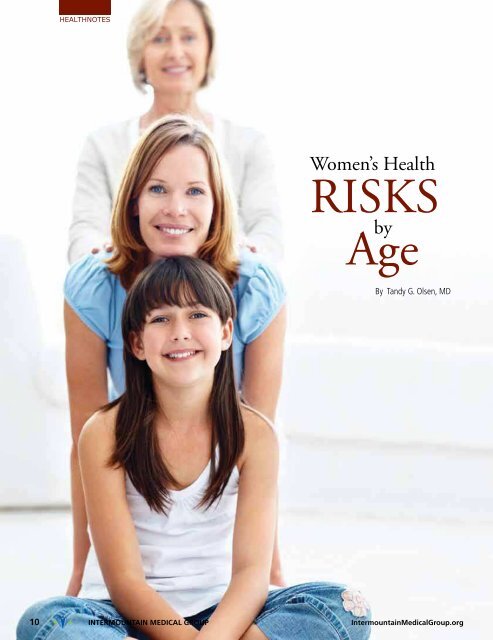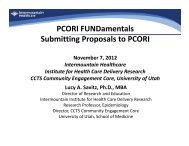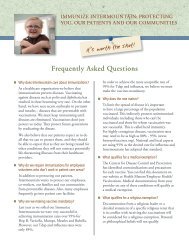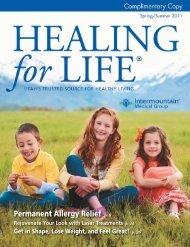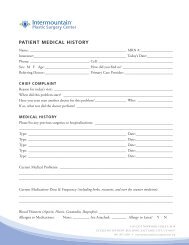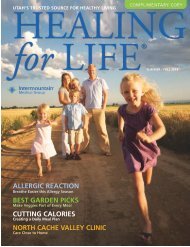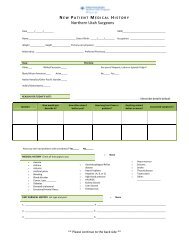Download the PDF - Intermountain Healthcare
Download the PDF - Intermountain Healthcare
Download the PDF - Intermountain Healthcare
You also want an ePaper? Increase the reach of your titles
YUMPU automatically turns print PDFs into web optimized ePapers that Google loves.
How can I decrease my risk of illness or death?<br />
This question is often <strong>the</strong> reason for preventive or wellness visits<br />
to <strong>the</strong> doctor. To answer this question, it helps to understand what<br />
<strong>the</strong> leading causes of death are for women of different age groups.<br />
Women’s Health<br />
RISKS<br />
by<br />
Age<br />
By Tandy G. Olsen, MD<br />
The teenage years<br />
The teenage years are characterized by experimentation<br />
and learning one’s limits. Girls and<br />
young women are testing boundaries and learning<br />
about relationships with o<strong>the</strong>r people. As<br />
such, it is not surprising that <strong>the</strong> leading causes<br />
of death in teenage girls are unintentional injuries<br />
and accidents. Two o<strong>the</strong>r leading causes of<br />
death are suicide and assault.<br />
20 - 39 Years<br />
As a woman matures, <strong>the</strong> risks of accidents or<br />
injuries begin to decrease and are replaced by<br />
<strong>the</strong> risk of cancer. Diabetes and cardiovascular<br />
diseases appear in <strong>the</strong> leading causes of death as<br />
well. Risks of death from HIV infection and<br />
liver diseases also appear in <strong>the</strong> top 10.<br />
40 - 64 years<br />
Surprisingly, <strong>the</strong> leading causes of death do not<br />
change much in this age group. Malignancy remains<br />
<strong>the</strong> number one cause of death. The risks<br />
of diabetes, stroke, and heart diseases increase<br />
and <strong>the</strong> risk of accidents decreases, but <strong>the</strong> leading<br />
categories are essentially <strong>the</strong> same.<br />
prevention<br />
While some of <strong>the</strong> diseases listed on <strong>the</strong> left are difficult or<br />
impossible to prevent, <strong>the</strong>re are things that can be done to<br />
decrease a person’s risk.<br />
Young women should know to act responsibly, to wear seat<br />
belts and drive carefully, and to be careful in <strong>the</strong>ir relationships<br />
with o<strong>the</strong>rs. Their families and friends need to watch<br />
for signs of depression or self-injury and to discuss concerns<br />
with <strong>the</strong>se girls.<br />
Diseases such as type 2 diabetes, cardiovascular disease, and<br />
hypertension are often closely related to obesity and lifestyle.<br />
Proper diet and exercise can largely prevent <strong>the</strong>se diseases,<br />
particularly if <strong>the</strong>se habits are formed as children and practiced<br />
throughout life.<br />
Many cancers cannot be prevented, but one’s risk of death<br />
from cancer can be decreased. Sunscreen decreases <strong>the</strong> risk<br />
of skin cancer. Early detection of precancerous conditions<br />
or early cancers are possible through screening examinations<br />
done at wellness visits with your physician.<br />
If you have concerns about any of <strong>the</strong>se conditions, please<br />
address your concerns with your personal physician.<br />
65 years and older<br />
The leading causes of death in women in this<br />
age group are heart disease, cancer, and stroke.<br />
O<strong>the</strong>r causes, such as infections and Alzheimers<br />
disease, also appear on <strong>the</strong> list.<br />
Tandy G. Olsen, M.D.<br />
Obstetrics and Gynecology<br />
Budge Clinic OB-Gyn<br />
435.716.1920<br />
10 INTERMOUNTAIN MEDICAL GROUP <strong>Intermountain</strong>MedicalGroup.org<br />
<strong>Intermountain</strong>MedicalGroup.org 11


